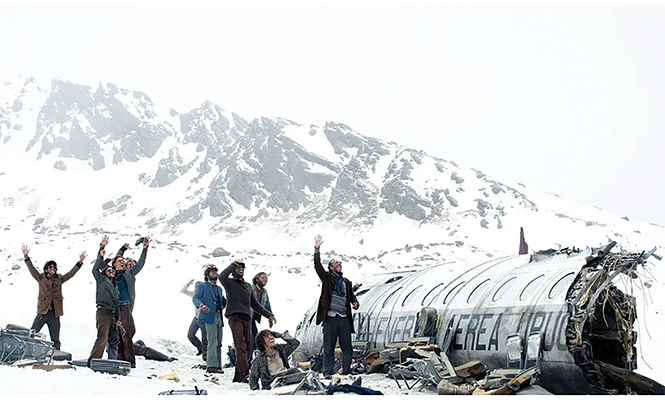Feature movie review: Society of the Snow
A new adaptation finds new power in a 50-year-old event.
By MaryAnn JohansonSociety of the Snow: That sounds nice, sorta winter-cozy, like it's a twee Hallmark Christmas movie. But this movie is anything but. Here we have another retelling, after 1993's Alive, of the real-life 1972 charted-plane flight from Montevideo, Uruguay, to Santiago, Chile, that ended in a horrific crash in the Andes Mountains, stranding the players of a young amateur rugby team, their friends and family, and the crew members on a snowy, inaccessible glacier. They had no cold-weather gear, minimal food, no way of summoning help and little chance of survival.
It's tough to know how much of this story is spoilable, given the media circus that surrounded the actual event, plus the studio production that was Alive, with future big names including Ethan Hawke and Illeana Douglas. Then again, the plane crash was half a century ago, and even Alive is 30 years old, closer in time to the events it depicts than it is to this new movie. It's possible some audience members may not be aware of the full story, so I'll be as circumspect as I can.
Perhaps it is that very passage of time that makes the harrowing reality of what the passengers faced on that glacier easier to tackle onscreen. Society is far blunter about the difficult decisions the crash survivors had to make in order to endure long enough for any rescue to reach them, and while Alive didn't exactly ignore those choices—it couldn't have, given that they were central the tale—it approached them warily, instead concentrating on the adventure aspects. In this new film, the moral, ethical and philosophical quandaries of sustaining oneself in body and spirit in impossible conditions takes center stage. The result is in many ways profoundly spiritual, sometimes in a specifically religious sense—the passengers were all devout Roman Catholics—but overall in a humanist way that even someone with no faith can be moved by.
Which isn't to say that Spanish filmmaker J.A. Bayona eschews the inevitable action of the plane crash; he depicts it with an immediacy that is traumatizing even for us watching. And dangerous exploits are also an inescapable part of the story, as when survivors begin to climb nearby peaks to survey their surroundings. Bayona plays all of this not for thrills, however, but with a mounting sense of horror at the vastness of the Andes. When a climber looks back from his summit and registers that the white plane fuselage is utterly invisible against the snow, the despair is palpable. How will they ever be found? Is rescue too much to hope for? How do you cling to hope?
The decades since Alive have changed the levels of authenticity we expect from a film like this. It's hard to imagine that this story told today could get away with casting American actors and having them speak dialogue in English, as the 1993 movie did. Indeed, Bayona's terrific and hugely engaging cast is exclusively Uruguayan and Argentinian, most of them newcomers. The nominal protagonist in this ensemble piece is Numa Turcatti, a passenger who wasn't even included in Alive; he is played by Enzo Vogrincic, who has the looks and the intensity of a young Adam Driver, and rivets the movie in his determination to survive. The script is based on the 2009 book of the same name by Uruguayan journalist Pablo Vierci, as well as more than 100 hours of interviews with still-living survivors. Some of the film was shot at the actual crash site. There is a sense of melancholy memorial about the film, the weight of so many young lives lost. As they die, their names and ages appear as legends onscreen.
Bayona has done disaster before in the 2012 tsunami survival drama The Impossible, which also focused on fragile people amidst vast catastrophe. But Society—Spain's submission for Best International Feature Film at the upcoming Oscars—shares a soul, too, with his horror movies, 2007's The Orphanage and 2016's A Monster Calls, and their aching confrontations with grief and death. What those people on the glacier went through is so extreme that most of us can barely fathom it, never mind have any experience to compare it to. Even if you already know the full extent of what it took to survive this nightmare, Bayona's rendering of it finds new power and universality in what they suffered.
More by MaryAnn Johanson
-
Film Reviews: New Releases for Dec. 8
The Boy and the Heron, Maestro, Eileen, Leave the World Behind
- Dec 7, 2023
-
Feature movie review: MAESTRO
Bradley Cooper's Leonard Bernstein biopic avoids cliché and offers electrifying audacity
- Dec 6, 2023
- More »



